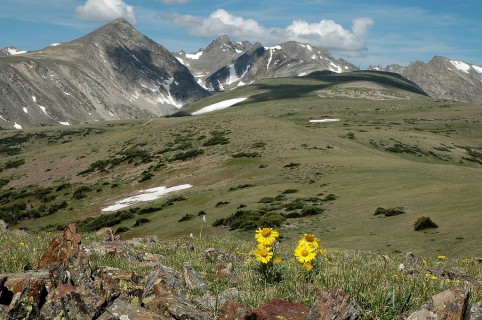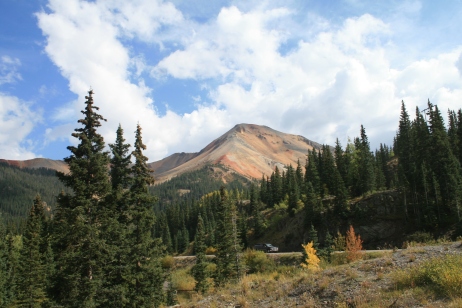Alpine ecosystems are islands of cold. They contain pockets of endemic biodiversity surrounded by a sea of hotter land. Mountains are thought to be particularly vulnerable to climate change because increased temperatures compromise species that are adapted to the coldest of habitats. As more species move to higher ground to escape warmer weather, what will happen to those that are already there? It is feared that species already adapted to the highest peaks will “fall off the top” of mountains or get pushed out by the plant world’s climate refugees moving up slope. This theory seems to pass a common sense test, but is this actually what is happening? Are species moving uphill, and if so, what is driving the upward expansion of their range?

Alpine ecosystem on Niwot Ridge in Colorado’s Front Range
Researchers from UC Berkeley, Lawrence Berkeley National Labs, University of Colorado, and elsewhere are working to answer these questions. Hundreds of experimental plots have been established on Niwot Ridge in Colorado’s Front Range to query what environmental factors determine the current range of a number of mountain dwelling plant species. Tree line, the elevation at which trees stop growing, has been advancing uphill in most regions of the globe over the past half century, however, this is not happening uniformly in all areas.
Investigations on two high elevation tree species, Engelmann spruce and limber pine, have shown that temperature may not be the primary factor determining their maximum elevation ranges. Researchers working on Niwot Ridge manipulated temperature and moisture in multiple experimental plots near tree line and observed seedling establishment under artificially varied temperature and water regimes.
Artificial heating of the plots with seeds sewn above tree line, designed to mimic climate change, actually resulted in reduced seedling survival compared to control plots. Warmer temperatures created drier soil conditions that negatively influenced seedlings. However, plots with artificial heating and supplemental water showed increased seedling survival and growth. Therefore, we can speculate that warmer temperatures will only induce up slope movement of tree line in circumstances where there is sufficient soil moisture. Otherwise, warmer temperature may exacerbate moisture stress and limit range expansion. This highlights the importance of accounting for local factors, such as water availability, in determining future range shifts.

Note transition from forest to alpine habitat in background
The topography of mountain ecosystems is extremely diverse, and warming temperatures affect water availability and plant survival differently depending where on the mountain they occur and what the individual species are adapted to. For example, snowfields melting earlier in the season negatively impact the survival of plants that are adapted to more persistent snow cover and shorter growing seasons- including mosses, lichens, and other snowfield plants. Meanwhile, wet meadows down slope of the snowfield may remain unchanged or transition to drier meadows if total moisture availability drops below a certain threshold.

Climate models are used to predict future climate scenarios
These changes are broadly important to climate models- computational tools that allow us to predict future climate change scenarios. This is because the difference between having a coniferous forest versus alpine tundra changes the way carbon and other greenhouse gases are cycled between the atmosphere and the land. Changes in Earth’s vegetation mean changes in Earth’s atmosphere. The aggregate of these changes all over the globe is something that climate models need to take into account if we are going to get better at predicting the effects of climate change. Mountain ecosystems are particularly heterogeneous topographically and ecologically which is why they present a poignant study system for this topic. They serve as a great reminder that a finer scale understanding of vegetation responses to climate change are needed to predict species’ range shifts and to create better climate models. The more our climate models take into account studies such as the one on Niwot Ridge, the better we will be at predicting the future climate.
Aside from their ecological importance, the mountains of the American West are iconic landscapes that provide a unique sense of place for both locals and visitors. Understanding what drives their ecological changes may also help us manage them in a more sophisticated way so that future generations can enjoy their intact ecosystems.
_________________________________________________________________
Original Scientific article (s)
Katharine N. Suding, Emily C. Farrer, Andrew J. King, Lara Kueppers
& Marko J. Spasojevic (2015) Vegetation change at high elevation: scale dependence
and interactive effects on Niwot Ridge, Plant Ecology & Diversity, 8:5-6, 713-725, DOI:
10.1080/17550874.2015.1010189
Moyes, A. B., Castanha, C., Germino, M. J., & Kueppers, L. M. (2012). Warming and the dependence of limber pine (Pinus flexilis) establishment on summer soil moisture within and above its current elevation range. Oecologia, 171(1), 271–282. http://doi.org/10.1007/s00442-012-2410-0
Photo Credit
Featured Image, Mountain Research Center
Niwot Ridge, Niwot Ridge LTER, Mountain Research Center
Engelmann spruce: By Jsayre64 (Own work) [CC BY-SA 3.0 (http://creativecommons.org/licenses/by-sa/3.0) or GFDL (http://www.gnu.org/copyleft/fdl.html)%5D, via Wikimedia Commons
Barren snow free peak, Andreas F. Borchert via Wikipedia
climate model data example, NOAA
Categories: Atmosphere, Conservation, Ecosystems
